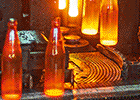Vitro Architectural Glass, the largest glass producer in the Western Hemisphere whose products continually raise the industry standard for sustainability, hosted the U.S. General Services Administration (GSA) and the U.S. Environmental Protection Agency (EPA) at its plant in Carlisle, Pennsylvania, to announce low embodied carbon (LEC) progress, its sustainability objectives and its work to improve environmental performance.
Vitro proudly announces that the GSA selected its low-embodied carbon, energy-efficient products for a renovation project at the Whittaker Courthouse in Kansas City, Missouri, and a test project at the Cohen Federal Building in Washington, DC.
The Whittaker Courthouse will feature Starphire Ultra-Clear® low iron glass by Vitro, one of the world’s clearest, most transparent float glass products. The Cohen Federal Building project will serve as a GSA Green Proving Ground program testing location. Several windows at the Cohen Federal Building will use one of Vitro’s highest-performing products, VacuMax™ Vacuum Insulating Glass (VIG), which delivers R-values up to R20, rivaling the thermal performance of traditional walls. The Lawrence Berkeley National Laboratory will conduct testing and performance evaluations for this project. Earlier this year, the GSA selected Solarban® solar control, low-e glass by Vitro for the Powell Courthouse and Annex renovations.
These renovation projects are part of President Biden’s Investing in America agenda and funding comes from the Inflation Reduction Act (IRA) of 2022. Additionally, these projects further the Biden-Harris Administration’s Buy Clean Initiative, under which the federal government is, for the first time, prioritizing the purchase of asphalt, concrete, glass and steel that have lower levels of greenhouse gas emissions associated with their production, use and disposal. These investments aim to expand America’s industrial capacity for manufacturing goods and materials of the future, tackle the climate crisis, and create good-paying jobs for workers in the region.
In 2017, Vitro became the first North American manufacturer to publish third-party verified Environmental Product Declarations (EPDs) for its flat glass and processed glass products. Recently, Vitro updated its EPDs to indicate that all its architectural glass products meet the top 20% LEC material global warming potential (GWP) threshold that GSA established pursuant to IRA and related guidance from the U.S. Environmental Protection Agency. GSA’s IRA requirements for flat glass require that products offer a Type III EPD with a GWP value expressed in kilograms of carbon (CO2) equivalent per metric ton and impose GWP limits that GSA established in May 2023 based on actual product-specific and industry-average EPDs.
With a GWP of 1,240 kilograms of CO2 equivalent, all Vitro architectural glass products meet GSA’s most-stringent “Top 20%” GWP limit of 1,331. This lowest embodied carbon designation applies to all Vitro-produced architectural glass from all Vitro plants manufactured since April 2024.
Vitro was also the first U.S. glass manufacturer to have its entire collection of architectural glass products earn Cradle to Cradle Certified® status. Recently, Vitro earned renewal of its Cradle to Cradle Certified® status, which included an increase in the certification levels of Material Health to the platinum level, the highest achievable certification, and Material Reutilization to the gold level.
“We are committed to continually raising the industry standard for sustainability and strongly believe in transparency, as shown in our recent updates to our EPDs and Cradle to Cradle Certified® achievements,” said Paul Bush, Vitro Architectural Glass Vice President, Technical Services, Sustainability & Government Affairs. “We’re very pleased that the GSA again selected our low embodied carbon glass for landmark renovation projects to improve the buildings’ energy efficiency and reduce its carbon footprint. Our research and development teams work tirelessly to continually improve our environmental performance so we can continue supporting architects, designers, fabricators and glaziers in meeting their sustainability goals.”
Vitro's commitment to sustainability transcends certification programs into its responsible manufacturing processes and large-scale energy reduction through its energy-efficient, low-e Solarban® glass products, which deliver a return on carbon by dramatically reducing a building’s operational carbon every year.
Vitro’s continued efforts to improve environmental performance and lower GWP include more efficient use of batch material, implementing furnace efficiency and design improvements, installing energy-efficient lighting and regulating equipment and driving supplier improvements.
Another significant factor in lowering GWP is Vitro’s patented oxy-fuel furnace technology, which melts glass raw materials such as sand and silica by carefully mixing pure oxygen (instead of air) with natural gas, significantly improving energy and environmental performance. This technology reduces energy consumption in glass-melting furnaces by as much as 20% and greenhouse gas emissions by 50%.



























